Lamps for a bath in a steam room: selection criteria
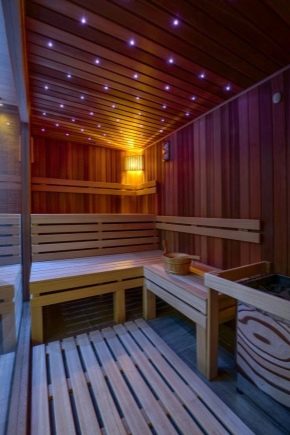
Bath lighting is different from what we have in a regular home. The modern view of the arrangement of this room implies taking into account two components: safety standards and aesthetic appeal. To understand how to choose a lamp for a bath, we will consider the main criteria to which it must obey, and also study the nuances of each variety.
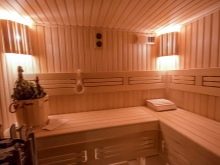
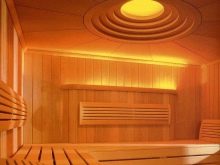
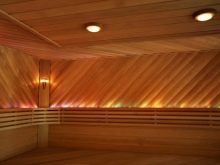
Requirements
It is no secret that the bathhouse is a place with a high degree of humidity. This is especially true for the steam room, where moisture rises up and has a negative effect on switches, sockets and lamps. For this reason, the lighting fixtures in the bath must have the correct placement, which is decided at the design stage.
There should be no outlet or switch in the steam room. They are taken out to a dressing room or other room with a lower moisture coefficient and connected at a height of at least 80 cm from the floor.
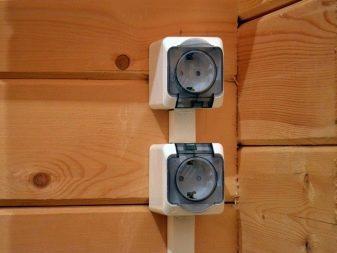
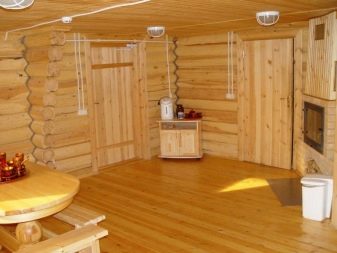
Consider the basic requirements for lamps in the steam room, which should not be less than the established IP-54 standards. These devices will have to work in difficult conditions, the marking in the form of a red IP-54 icon says on the safety of the luminaire when operating in high humidity conditions:
- IP stands for International Protection;
- 5 - degree of protection against solid objects;
- 4 - protection against steam and moisture seepage.
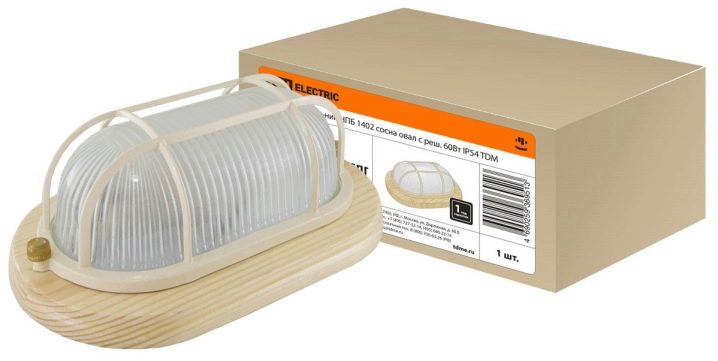
There are 4 main criteria that you need to pay attention to.
- All components of a steam room lighting device must be heat resistant. This means that they must withstand temperatures up to 120 degrees.
- The luminaire housing must be sealed. This rule is especially relevant for devices that use incandescent lamps. Each luminaire must have a closed shade.
- It is important that the cover of the device is strong. The structure must withstand not only accidental mechanical stress. A sharp temperature drop is also important, which should not be reflected in the material of the plafond.
- The brightness of the luminaire should be moderate. The bathhouse is a place for relaxation; you don't need to create bright light here. It is important that the glow is soft and diffused.
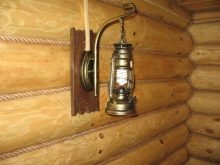
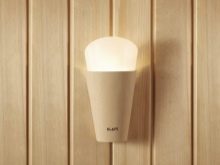

The choice of housing and lamp power
The housing of the heat-resistant lighting device for the walls and ceiling of the steam room is different. If the luminaire is mounted in a wall, it must withstand temperatures of about 250 degrees. When the device is mounted to a wall, a 100 degree mark is sufficient.
The plafond material can be:
- porcelain;
- ceramics;
- heat-resistant plastic.
It is necessary that the seal is made of rubber or silicone. This will prevent moisture from getting inside the plafond.



Pendant lighting cannot be used in the steam room - it is better to purchase near-surface lamps.
The maximum allowable power of light sources should not exceed 60-75 watts. If the power of the bulbs is greater, this will provoke heating of the plafond. The recommended voltage is 12 V. To maintain it, you will need a transformer, which must be placed outside the steam room.

Location principles
Installation of lamps for a bath in a steam room is subject to certain principles of placement.
- It is impossible to install lighting devices near the stove, even taking into account the fact that the lamps are heat-resistant and waterproof.No appliance is designed for powerful heaters.
- An excessively yellow and cold tint of the luminous flux is unacceptable. You cannot equip the space with a large number of devices - this is harmful to the eyes and will create pressure on the retina.
- The arrangement of the devices should be such that during any movement it could not be hit by the head, hands, or a broom.
- To prevent the device from hitting the eyes, it should be positioned so that it is behind the back or in the corner of the steam room.
- The ideal placement is considered to be a wall-mounted luminaire at a distance equal to half the height of the wall. This will reduce the load on the device.

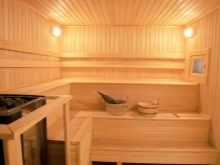
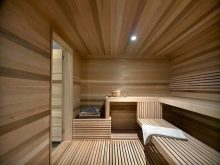
Varieties
To date, luminaires for a steam room in a bath are classified according to the type of device and the source of the lamp. Let's consider the types of models.
Traditional
These devices are nothing more than classic lamps in closed shades, which are mounted on a wall or ceiling. The design is characterized by a laconic shape (usually round), consists of a reliable and sealed case, as well as heat-resistant glass, predominantly matte. These models have a low cost, which makes them popular among buyers. They are reliable in functionality, but the decisive factor is the type of light source used under the shade. The design does not have parts prone to corrosion under the influence of moisture, they are equipped with a special waterproof gasket. The models are subject to the protection class of the established standard.
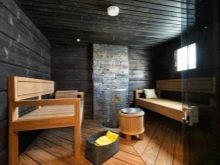
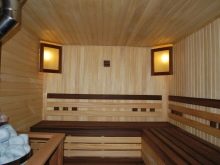

LED
These devices are now firmly included in the top three most popular models, they have a lot of varieties. The main advantage of these devices is resistance to any temperature conditions and moisture. Depending on the type of lamp, it can even be mounted on the bottom of the pool, so this device for a bath is much better than other types. The appearance of such devices depends on the wishes of the buyer.
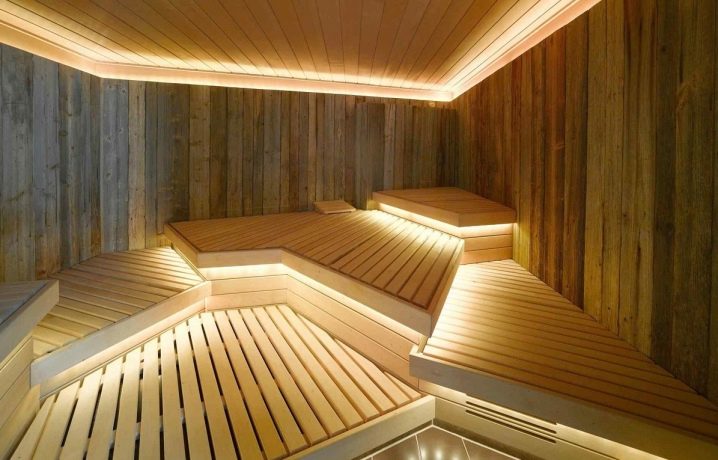
A distinctive feature of sealed devices is the presence of a special silicone filmthat protects light sources. The sizes of LEDs can be different, which is reflected in the degree of intensity of the luminous flux. At the same time, the presence of a film makes the light soft and diffused. In shape, LED luminaires are point models, panels and flexible diode tape with different density of diodes per square meter.

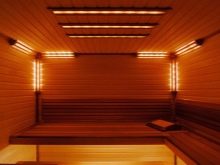
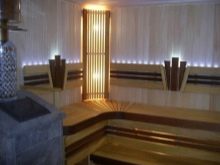
Fiber optic
These devices are glass filaments with light sources at the ends. Outwardly, they resemble a panicle-shaped lamp with luminous ends. This lighting has a high degree of safety, since fiber optic filaments are able to withstand temperatures up to 200 degrees. They are not afraid of any extreme conditions, these lamps are durable, provide even and soft light in the steam room.
The advantage of such lighting is the fact that you can do it yourself.without resorting to the help of a specialist from outside. In this case, an important factor is the installation of the projector outside of moisture and heat (in another room), while the wires themselves can go into the steam room, making up, for example, a wall panel. Moreover, the thicker the beam, the more design possibilities (for example, you can recreate a starry sky with twinkling stars of different sizes).
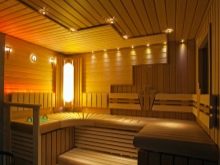
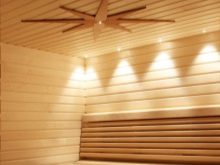
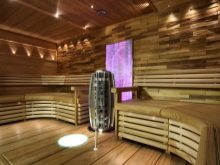
Sources of light
According to the type of light sources, lamps are divided into several categories. Let's look at the main ones to understand their relevance in the steam room. Not knowing these nuances can lead to a dangerous situation.
Incandescent lamps
These light sources are classic Ilyich bulbs. They have an incandescent filament and shine with a predominantly warm light. The advantage is the price, but they have more disadvantages. They convert the main part of the consumed electricity into heat - a small part is spent on light (no more than 5% of the total consumption).At the same time, even without high temperature, the lamps heat up so much that touching them can provoke a burn. They are uneconomical, add warmth to the ceiling, and are dangerous for the steam room. These include halogen lamps, the properties of which are somewhat better.
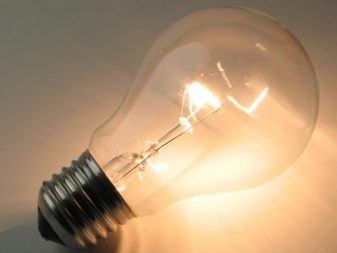
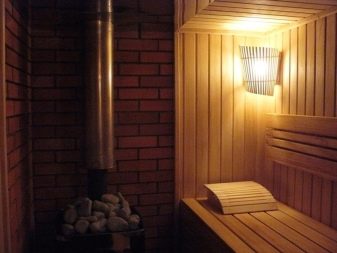
Luminescent
These models are nothing more than the usual energy-saving light bulbs, which are distinguished by a high price and are advertised as harmless. They are a luminous gas discharge tube with a power of 11 watts, which converts UV radiation into visible light using a phosphor and a discharge of mercury vapor. They are electroluminescent, cold cathode and hot start, flicker and buzz during operation. Their service life is longer than incandescent lamps, compared to them, these varieties emit less carbon dioxide into the air, are unstable to power surges. In the process of work, mercury vapor is emitted into the room.


LED
These light sources are rightfully recognized as harmless. Their price is not much different from luminescent ones. At minimum power, they shine brightly enough, in fact, they are energy-saving and do not contain mercury. The service life of such light sources is longer than any other analogue.
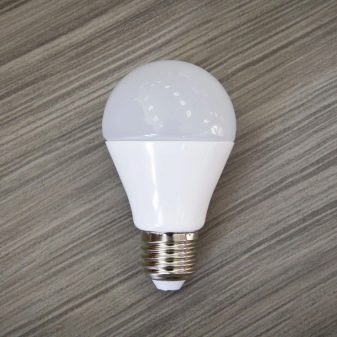
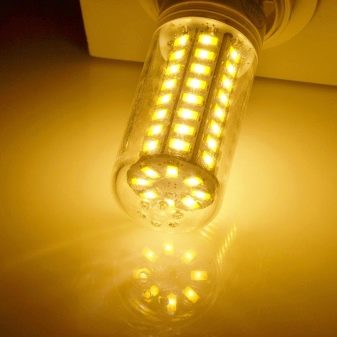
Their glow is directional, so it will not work to illuminate the entire space without shadow corners with one such lamp. However, if you use a strip lamp around the perimeter with two rows of diodes, you can achieve even lighting in the steam room. Due to its elasticity, the tape can be routed around the perimeter without the need for cutting. It is easy to fix it, which allows you to perform corner lighting options.
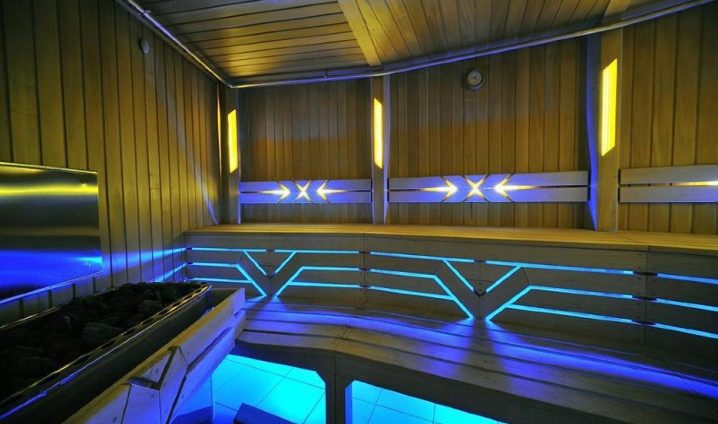
How to choose?
When choosing a lamp for a bath in a steam room, you should pay attention to several nuances, the knowledge of which will prolong the operation of the device and will not make you think about its safety.
- When choosing, give preference to a device with a matte anti-fog lamp. With its help, the glow will be soft and diffused.
- Do not use portable mains powered lighting devices.
- Exclude daylight fixtures containing mercury from the selection list. In addition to the fact that in the process of work they will release it into the air, in case of an accidental impact, the concentration of toxins will be especially dangerous to health. If the temperature in the steam room is high, these light sources may burst.
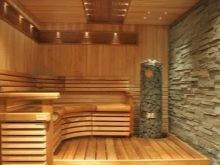
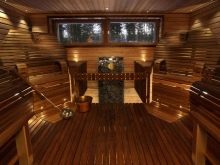
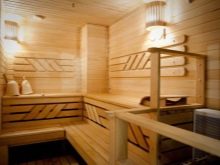
- The class of sockets must not be less than IP 54, while the switch can be marked up to IP 44, but not lower.
- It makes sense to buy fiber-optic lamps: they are safer than incandescent lamps, have a pleasant light glow for the eyes.
- If the steam room and washing room are combined, pay special attention to the safety of the lamps. If this unit is going to be wall-mounted, take care of an additional lampshade or shield.
- If your budget allows, opt for models with touch motion sensors.
- In addition to wall lighting, emergency lighting may also be needed. In this case, LED strip will be the best solution.
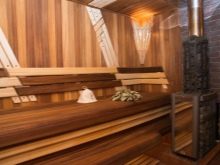
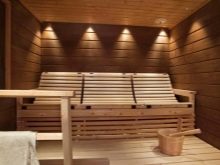

Also, don't forget the 4 golden rules for buying:
- you need to buy lamps and lamps in a trusted store with a good reputation;
- this product cannot be made from cheap raw materials;
- if possible, check the operation of the lamps in the store itself;
- do not take a discounted product - this is the first sign of marriage.
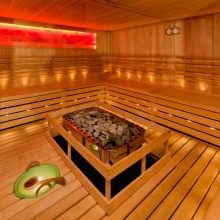
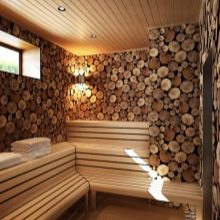
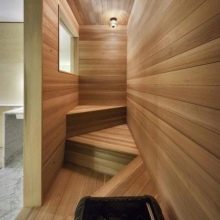
Installation
Each head of the family can mount lighting in the steam room with their own hands. To do this yourself correctly, it is worth taking care of a preliminary diagram in the form of a wiring drawing, on which the locations of the lamps are indicated. In addition, it is important to purchase a wire with the desired cross-section, which depends on the number of fixtures. It is necessary to calculate the load and study the organization of grounding.
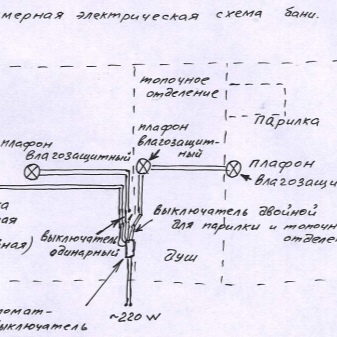

Let's take a look at a brief step-by-step instruction for installing the backlight in the bath.
- The location of the lamp is marked with a cross. If you plan to install two devices, they must be symmetrical.
- Power wiring is carried out by means of a three-core wire packed in a protective corrugation.
- The gasket is performed away from the cut-in lighting in order to prevent the wires from melting during the operation of the lamps, fixing the wire to the crate or frame by means of special clips.
- When supplying power for a group of lighting devices, the cable is laid in a loop with loops. If you plan to install devices with small mounting caps, you should use a single wire from the junction box.
- It is necessary to check the wiring, for which a lamp holder and a wire are used. Do not rely on a tester to indicate the phase: it will not show zero loss. If the result is positive, the stripped wire ends must be insulated.


- After conducting the wiring, the wall cladding is performed, while at the same time cutting holes for the fixtures. The diameter of the required hole is indicated in the passport of a specific product. To do this, markup is performed, then use a drill or screwdriver.
- If the model is a surface-mounted type, the mounting plate is fastened with dowels, avoiding getting under the wire. After that, the power is connected, observing the polarity. Then the luminaire is fixed with screws.
- To install the mortise model, the loops of the wire are cut, after which the two resulting ends of the cable are connected to the ceramic cartridge by means of twists, trying to wind the ends from the bottom of the screws under the terminal block. In this case, you can not do without winding it with electrical tape.
- If the lamp power is 12 W, a step-down transformer must be added to the circuit. This is done through the hole for the luminaire, placing the transformer up to 1 device (so it will be easier to change it if necessary).
- Since the devices are mounted without lamps, it is necessary to check their operation at this stage.
- It remains to close the plafond and check the difference if there are several lamps.


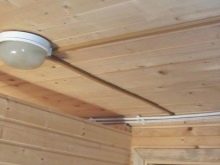
When passing the light into the steam room, flax cannot be used as a seal for the plafond: it expands under the influence of moisture, contributes to condensation in the lamp holder.

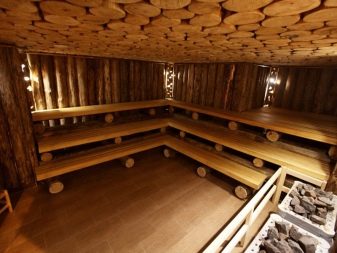
See the following video for a clear picture of connecting the electrical wiring in the bath.
Manufacturers
Having studied the main criteria for choosing a lamp in a steam room and installation techniques, the question arises of choosing a specific brand with a good reputation. There are many models on the modern market.
Products of Turkish and Finnish manufacturers are in particular demand. For example, Finnish brands Tylo and Harvia offer to the attention of buyers specialized moisture-resistant models for baths.
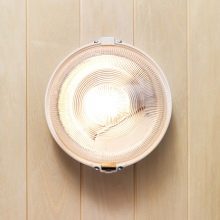
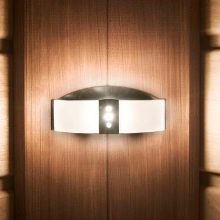

These products are distinguished by their high cost, which is justified by high-quality performance characteristics. Models of the brands have a case made of metal and wood, they can be equipped with a plastic diffuser. They are safe, which increases their rating in their segment.
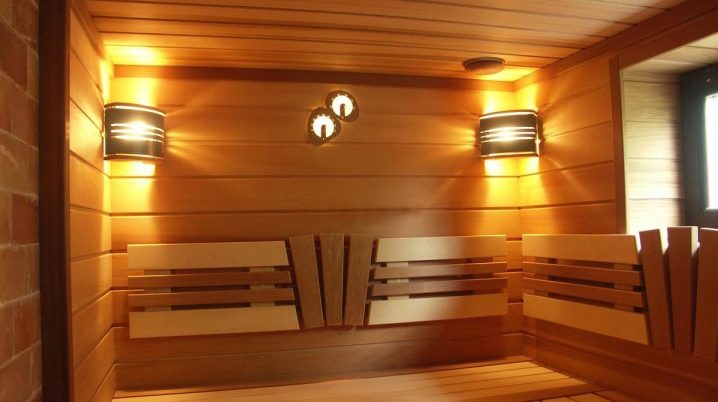
In addition to these companies, products are in demand Linder, Steinel... However, according to reviews, these models, although heat-resistant and equipped with protection from moisture, in fact do not differ in moisture resistance. You can also take a closer look at the company's products. TDM Electric.

Interesting options
To evaluate the possibilities of a design approach to the design of lighting in a steam room, you can refer to the examples of the photo gallery.
- Reception of using a ledge for fiber-optic illumination with a transition from wall to ceiling.
- The lighting along the perimeter of the ceiling with a strip lamp with a change in color and fiber-optic filaments create the desired mood and an original look of the steam room.


- An example of using LED backlighting with additional wall lighting in the form of symmetrical luminaires covered with grilles.
- The use of spotlights and fiber optics creates a stylish combination of lighting in the steam room. The use of adjacent walls in combination with the uncomplicated pattern created by the light looks unusual.
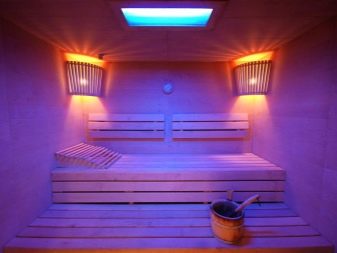
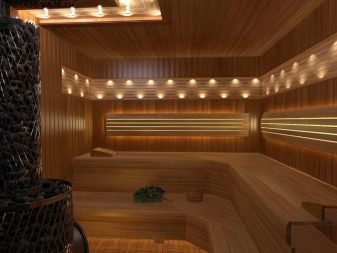
- The use of spot, linear and built-in lamps creates a special effect, immersing households in an atmosphere of relaxation.
- The use of spot lighting along the perimeter of the broken ceiling structure will allow you to even out the degree of lighting in the steam room.
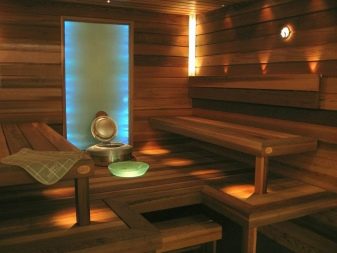
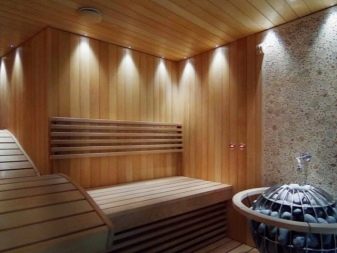
- Combined lighting with RGB type LED strip with multi-colored LEDs and a wall lamp allows you to create a special atmosphere in the steam room.
- The powerful lamps in the corners above the seating benches are completely safe: they are fitted with grilles in the same style as the wall decor.
- An example of a linear type of indoor wall lighting: thanks to the wooden slats, the lamps are protected from accidental mechanical damage.
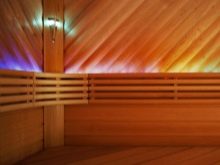
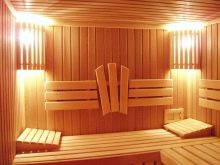
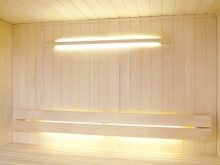
- Reception of the arrangement of lamps in the corners of the steam room creates a welcoming atmosphere: soft and warm light does not hit the eyes, allowing the owners of the house to relax to the maximum extent.
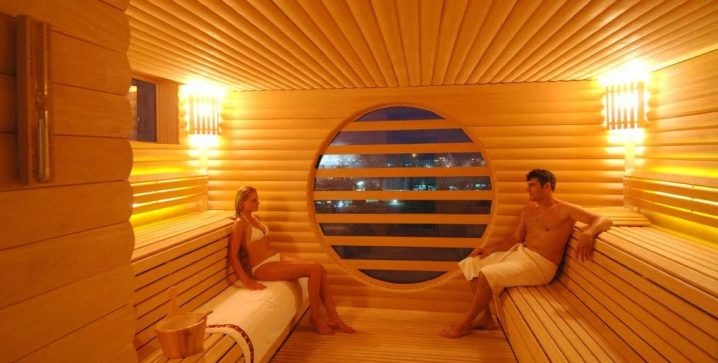
You can find out how to save money on buying a lamp for a bath from the following video.













The comment was sent successfully.